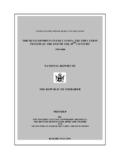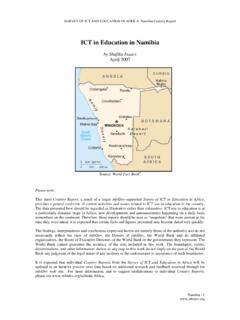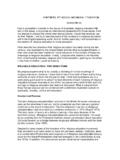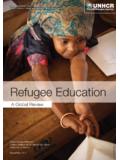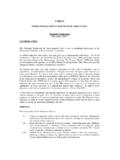Transcription of High Level Group on the Modernisation of Higher …
1 High Level Group on theModernisationof Higher EducationNew modes of learning and teaching in Higher educationREPORT TO THE EUROPEAN COMMISSION ONOCTOBER 2014 High Level Group on theModernisationof Higher EducationNew modes of learning and teaching in Higher educationREPORT TO THE EUROPEAN COMMISSION ONOCTOBER 2014 European CommissionReport to the European Commission onNew modes of learning and teaching in Higher educationOctober 2014 Luxembourg: Publications Offi ce of the European Union2014 68 pp. 17,5 x 25 cmISBN 978-92-79-39789-9 information on the European Union is availableon the internet: European Union, 2014 The content of this Report does not refl ect the offi cial opinionof the European Union.
2 Responsibility for the information and views expressed in the publication lies entirely with the is authorised provided the source is acknowledgedPrinted in LuxembourgPrinted on elemental chlorine-free bleached paper (ECF) We need technology in every classroom and in every student and teacher s hand, because it is the pen and paper of our time, and it is the lens through which we experience much of our world. David Warlick ..if we teach today as we taught yesterday, we rob our children of tomorrow. John Dewey|5||4|REPORT TO THE EUROPEAN COMMISSION ONNew modes of learning and teaching in Higher educationThe online and open education world is changing how education is resourced, delivered and taken up.
3 Over the next 10 years, e-learning is project-ed to grow fi een-fold, accounting for 30% of all ed-ucational provision. But this transformation should be shaped by educators and policy-makers, rather than something that simply happens to them. And the ben-efi ts of these developments should be available to all Europeans. This is why, with my colleague Neelie Kroes, Commission Vice-President responsible for the Digital Agenda, we launched a joint initiative in 2013 on Open-ing Up education , to set out a framework for enhancing learning and teaching through new technologies and open digital content at all levels of Higher education , new technologies have enormous potential to ef-fect change.
4 They enable universities to meet a broader range of learners needs, adapting traditional teaching methods and off ering a mix of face-to-face and online learning possibilities that allow individuals to learn an-ywhere, anytime. They also create openings to engage in new kinds of col-laboration and off er opportunities to distribute resources more eff ectively. Given the societal and economic potential that can come from harnessing technological innovation in Higher education , it is imperative that Europe takes the lead in this many universities are not yet ready for this change and govern-ments have been slow to take the lead.
5 While there are instances of inno-vation, the landscape is fragmented, various barriers prevent widespread uptake, and fully-fl edged institutional or national strategies for adopting new modes of learning and teaching are few and far between. This is why, a er last year s successful report on Improving the quality of teaching and learning in Europe s Higher education institutions , I invited the High Level Group for the Modernisation of Higher education to set out recommenda-tions on enhancing Higher education through new technologies.
6 Androulla VassiliouEuropean Commissioner for education , Culture, Multilingualism and YouthI would like to thank the chair, Mary McAleese, and all the members of the High Level Group for the time, expertise and enthusiasm they have devoted to this issue. This balanced and incisive report shows clearly that Member States, supported by the European Union, have to act swi ly to set the right frameworks so Higher education institutions can make best use of the potential these new modes off er, enabling Eu-rope to become a global player in transformative Higher European Commission will play its part, off ering funding through the Erasmus+ programme to policy-makers and education providers to take forward the recommen-dations given by the Group .
7 One recommendation that the European Commission has already put into practice: all educational materials supported by Erasmus+ are freely available to the public under open licences. We hope our good practice will be copied across our Union.|6||7|REPORT TO THE EUROPEAN COMMISSION ONNew modes of learning and teaching in Higher educationA plethora of new terms have been making re-cent headlines in Higher education xMOOCs, cMOOCs, SPOCs, DOCCs .. with the promise, or threat, that digital technology will revolutionise our traditional, bricks and mortar universities.
8 In a fast-changing discourse, even to cite these acronyms is to risk being out of date, and this was one of the challenges the High Level Group faced when tack-ling our second report on new modes of learning and teaching in Higher education keeping pace with de-velopments, without being derailed either by prophets of doom or purveyors of of this made the report a constantly moving target; now, we hope, we have nailed it down, taking not so much a snapshot as a freeze-frame of the Higher education landscape, and examining it long enough to detect the change that is happening, but also the resistance that may be slow-ing it down and the barriers that prevent exploration of the topic confi rmed that MOOCs and their cousins are only one part of a wave of innovation in Higher education , as blended learning or other forms of on- and off -campus learning take off.
9 These are multiplying the opportunities for learners at the same time as the latter s numbers, and kind, grow apace with Europe s need for a highly skilled, fl exible workforce. Nonetheless, this wave of innovation is pro-gressing at a very uneven pace across Europe, and we risk being le behind as other parts of the world act more nimbly in garnering the benefi ts of technology including by resourcing the teachers on whom successful adoption of technology pedagogy and curriculum design are matters for institutions, gov-ernments are responsible for defi ning the policy.
10 Legal and funding con-texts which impact on the motivation and ability of institutions to inte-grate new modes across Higher education provision. This is why we have sought, where possible, to direct our recommendations to policy-makers, and to urge strategic action to tackle the key challenges we identify: in-stigating an open culture for change; developing political and institution-Mary McAleeseChair of the EU High Level Group on the Modernisation of Higher Educational leadership; supporting digital skills for teachers and learners.










